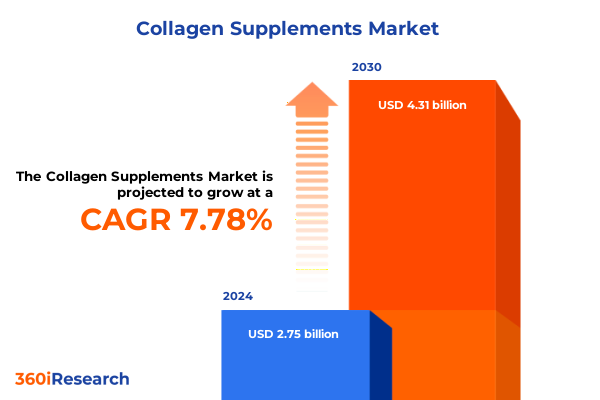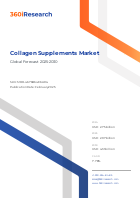The Collagen Supplements Market size was estimated at USD 2.75 billion in 2024 and expected to reach USD 2.97 billion in 2025, at a CAGR 7.78% to reach USD 4.31 billion by 2030.

Introduction to the Collagen Supplements Market Dynamics
The collagen supplement market has emerged as a focal point for health and wellness stakeholders, driven by growing consumer awareness of joint health, skin vitality, and overall well-being. As lifestyles become increasingly sedentary and aging populations expand globally, the demand for high-quality collagen peptides has surged. Beyond traditional bovine sources, manufacturers are exploring marine and plant‐based alternatives to cater to diverse dietary preferences and ethical considerations. This report provides an in‐depth examination of key market drivers, emerging trends, and stakeholder strategies shaping the collagen landscape. By offering a comprehensive overview of market dynamics, regulatory shifts, and competitive developments, decision‐makers can align product innovation and go-to-market approaches with evolving consumer expectations. Ultimately, this introduction sets the stage for an executive summary that navigates the complexities of sourcing, segmentation, tariffs, and regional nuances essential for sustainable growth in the collagen supplements arena.
Transformative Shifts Redefining the Collagen Landscape
Over the past five years, the collagen supplements space has experienced transformative shifts that extend far beyond incremental product launches. First, consumers are increasingly prioritizing plant-based alternatives alongside established bovine and marine sources, prompting manufacturers to invest in innovative extraction techniques from agricultural fields and grasslands. Personalized nutrition platforms now leverage digital assessment tools to recommend tailored collagen blends, reinforcing a shift toward data-driven consumer engagement.
Simultaneously, sustainability credentials have vaulted to the forefront, with brands tracing raw materials from seas & oceans sources and poultry farms to validate eco-friendly practices. Regulatory bodies have responded with more stringent labeling requirements for claims around anti-aging and joint health, intensifying the role of third-party certification. The rise of e-commerce platforms alongside health food stores and pharmacies has reshaped distribution channel strategies, compelling brands to optimize omnichannel experiences and direct sales models. These shifts collectively underscore a more diversified, transparent, and tech-enabled collagen ecosystem, where agility and consumer centricity define competitive advantage.
Cumulative Impact of United States Tariffs in 2025
With the introduction of new United States tariffs in 2025 targeting select marine-based ingredients and finished collagen formulations, import costs have risen by an average of 8–12 percent. Manufacturers that historically relied on wild-caught fish extracts from seas & oceans have reassessed supply chains, pivoting toward farmed fish sources or domestic production from livestock operations to mitigate margin erosion.
These tariffs have also accelerated strategic partnerships between importers and agricultural cooperatives to secure long-term contract pricing for bovine- and porcine-based hydrolysates. While end-users continue to accept moderate price increases, retailers and online platforms are scrutinizing promotional strategies to preserve shelf velocity. In turn, some brands have introduced higher-concentration liquid concentrates and flavored powder blends to justify premium positioning. The cumulative impact of these tariffs underscores the importance of supply chain resilience, with stakeholders prioritizing diversified sourcing and inventory buffering to navigate ongoing trade uncertainties.
Key Segmentation Insights Across Types, Forms, Applications, and Channels
Analyzing market segmentation by type reveals that bovine-based collagen remains the dominant category, led by feedlot cattle extracts favored for consistent peptide profiles, while grass-fed cattle sources are gaining traction among premium-oriented consumers seeking cleaner labels. Chicken-based collagen supplements occupy a niche segment driven by poultry farm partnerships that emphasize scalable extraction, whereas marine-based options draw on both farmed fish operations and wild-caught fish supplies to appeal to sustainability-conscious demographics. Plant-based alternatives are emerging as a disruptive force, tapping into novel sources in agricultural fields and grasslands to address vegan and flexitarian demand. Porcine-based formulations continue to serve specialized therapeutic applications.
Examining form segmentation highlights that powdered formulations, available in both flavored and unflavored varieties, represent the largest share due to versatility in functional beverages and protein bars. Liquid forms-encompassing concentrated serums and ready-to-drink shots-are rapidly expanding as on-the-go formats for anti-aging and joint health regimens. Capsules and tablets maintain steady growth among traditional supplement consumers, while gummies cater to kid-friendly and wellness-driven adult segments.
Shifts in application segmentation show cosmetics leveraging collagen in anti-aging creams, hair care, and skin care, while medical products remain focused on wound healing and joint support. Nutritional product strategies are bifurcated between athlete nutrition and elderly nutrition, reflecting divergent performance and recovery priorities. Distribution channels blend direct sales models with offline retailers spanning health food stores and pharmacies, alongside online retailers via branded websites and e-commerce platforms. Finally, end-user segmentation distinguishes general wellness individuals from professional buyers, including athletic trainers and medical practitioners, underscoring tailored go-to-market tactics.
This comprehensive research report categorizes the Collagen Supplements market into clearly defined segments, providing a detailed analysis of emerging trends and precise revenue forecasts to support strategic decision-making.
- Type
- Form
- Application
- Consumer Demographics
- Distribution Channel
- End-User
- Source
Key Regional Insights from Americas, EMEA, and Asia-Pacific
The Americas region continues to lead in total collagen consumption, driven by North American demand for anti-aging cosmetics and athlete nutrition. United States market players leverage direct sales and e-commerce platforms, while Latin American markets show growing interest in functional beverages enriched with flavored powders. In Europe, Middle East & Africa, regulatory harmonization across the EU and GCC has facilitated cross-border trade for both bovine- and marine-based supplements, supporting growth in both brick-and-mortar health food stores and pharmacies. Europe’s mature anti-aging cream segment complements emerging nutraceutical launches in the Middle East.
Asia-Pacific stands out for its rapid expansion, as rising disposable incomes in China, India, and Southeast Asia fuel demand for capsule and gummy formats tailored to skin care and joint health. Japan and South Korea maintain leadership in marine collagen innovations, drawing on advanced extraction from farmed fish and wild-caught sources. Regional distribution networks combine traditional retail partnerships with booming e-commerce penetration, particularly through localized marketplaces. These regional dynamics highlight the necessity for tailored product formulations and channel strategies to capture nuanced consumer preferences.
This comprehensive research report examines key regions that drive the evolution of the Collagen Supplements market, offering deep insights into regional trends, growth factors, and industry developments that are influencing market performance.
- Americas
- Asia-Pacific
- Europe, Middle East & Africa
Key Company Insights and Strategic Approaches
Leading companies are deploying distinct strategies to secure market share and foster innovation. Amicogen Co., Ltd. focuses on R&D collaborations to develop high-purity enzymatic hydrolysates, while Aspen Naturals invests in digital marketing campaigns that showcase transparent supply chain traceability. BioCell Technology LLC integrates proprietary bioconversion processes to offer multi-peptide complexes targeting skin elasticity. ConnOils LLC and Darling Ingredients Inc. leverage by-product streams from poultry farms and meat processing operations to reinforce cost-effective sourcing.
Foodmate Co., Ltd. and Gelita AG emphasize tailored solutions for functional food manufacturers, offering customized flavor profiles and solubility enhancements. Italgel S.r.l. and Juncà Gelatines SL concentrate on sustainable extraction from both agricultural fields and rivers & lakes, aligning with circular economy principles. Nippi Inc. and Nitta Gelatin India Limited expand their presence in Asia-Pacific through joint ventures and localized production facilities. Nutra Food Ingredients, LLC explores partnerships with athlete training centers, while Rabj Co., Ltd. pioneers vegan collagen analogues. Vinh Hoan Corporation and Vital Proteins LLC drive market education through influencer partnerships, and Weishardt prioritizes quality certifications to differentiate in competitive markets.
This comprehensive research report delivers an in-depth overview of the principal market players in the Collagen Supplements market, evaluating their market share, strategic initiatives, and competitive positioning to illuminate the factors shaping the competitive landscape.
- Amicogen Co., Ltd.
- Aspen Naturals
- BioCell Technology LLC
- ConnOils LLC
- Darling Ingredients Inc.
- Foodmate Co., Ltd.
- Gelita AG
- Italgel S.r.l.
- Juncà Gelatines SL
- Nippi Inc.
- Nitta Gelatin India Limited
- Nutra Food Ingredients, LLC
- Rabj Co., Ltd.
- Vinh Hoan Corporation
- Vital Proteins LLC
- Weishardt
Actionable Recommendations for Industry Leaders
Industry leaders should prioritize diversifying raw material sourcing by establishing dual supply agreements with feedlot and grass-fed cattle operations, while also piloting plant-based collagen analogues to capture emerging vegan segments. Investing in scalable extraction technologies can improve cost efficiency and accommodate fluctuations in wild-caught fish yields. Embracing digital platforms for personalized nutrition assessments will enhance consumer engagement and loyalty, particularly among athlete and elderly demographics. Strengthening partnerships with offline retailers and pharmacies alongside direct-to-consumer channels can optimize market coverage.
Monitoring regulatory changes is essential; proactive labeling compliance and third-party certifications will mitigate trade disruptions. Companies should explore tiered product portfolios-ranging from premium anti-aging serums to value-priced powdered supplements-to address varied consumer budgets. Finally, adopting sustainability metrics-such as carbon footprint tracking from seas & oceans sources and social impact reporting-will resonate with ethically conscious buyers and reinforce long-term brand equity.
Explore AI-driven insights for the Collagen Supplements market with ResearchAI on our online platform, providing deeper, data-backed market analysis.
Ask ResearchAI anything
World's First Innovative Al for Market Research
Conclusion: Navigating Complexity with Innovation and Resilience
In summary, the collagen supplements market is undergoing a period of rapid evolution characterized by source diversification, form innovation, and regional differentiation. Tariff dynamics in the United States underscore the criticality of resilient supply chains and adaptive pricing strategies. Segmentation insights reveal nuanced preferences across types-from bovine-based feedlot extracts to marine-derived peptides-and applications that span cosmetics, nutritional products, and medical therapies. Companies that leverage digital tools for personalized experiences, prioritize sustainability credentials, and cultivate omnichannel distribution models will be best positioned to lead in this competitive arena.
This section provides a structured overview of the report, outlining key chapters and topics covered for easy reference in our Collagen Supplements market comprehensive research report.
- Preface
- Research Methodology
- Executive Summary
- Market Overview
- Market Dynamics
- Market Insights
- Cumulative Impact of United States Tariffs 2025
- Collagen Supplements Market, by Type
- Collagen Supplements Market, by Form
- Collagen Supplements Market, by Application
- Collagen Supplements Market, by Consumer Demographics
- Collagen Supplements Market, by Distribution Channel
- Collagen Supplements Market, by End-User
- Collagen Supplements Market, by Source
- Americas Collagen Supplements Market
- Asia-Pacific Collagen Supplements Market
- Europe, Middle East & Africa Collagen Supplements Market
- Competitive Landscape
- ResearchAI
- ResearchStatistics
- ResearchContacts
- ResearchArticles
- Appendix
- List of Figures [Total: 30]
- List of Tables [Total: 860 ]
Call to Action: Connect with Ketan Rohom for the Full Market Research Report
To gain a comprehensive understanding of these insights and develop a winning strategy, reach out to Ketan Rohom, Associate Director, Sales & Marketing. Learn how our in-depth analysis can inform product development, streamline sourcing decisions, and enhance your competitive positioning in the collagen supplements market.

- How big is the Collagen Supplements Market?
- What is the Collagen Supplements Market growth?
- When do I get the report?
- In what format does this report get delivered to me?
- How long has 360iResearch been around?
- What if I have a question about your reports?
- Can I share this report with my team?
- Can I use your research in my presentation?




